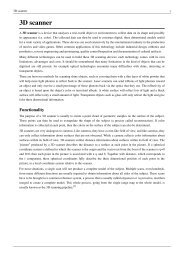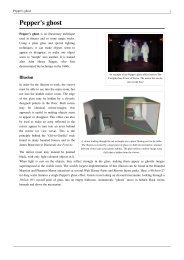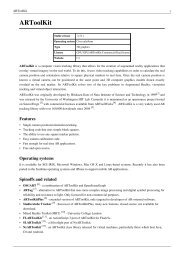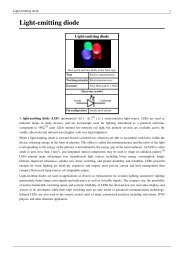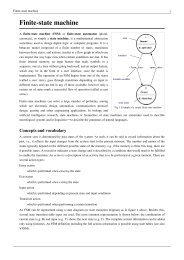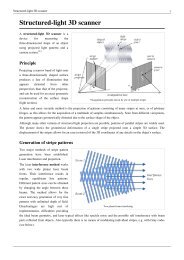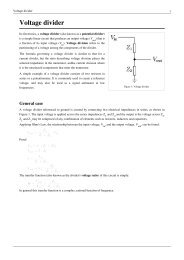Helmet mounted display - Wikipedia, the free ... - Ex-ch.com
Helmet mounted display - Wikipedia, the free ... - Ex-ch.com
Helmet mounted display - Wikipedia, the free ... - Ex-ch.com
You also want an ePaper? Increase the reach of your titles
YUMPU automatically turns print PDFs into web optimized ePapers that Google loves.
<strong>Helmet</strong> <strong>mounted</strong> <strong>display</strong> 4<br />
Display And Sight <strong>Helmet</strong> (DASH)<br />
The Elbit Systems DASH III was <strong>the</strong> first modern Western HMD to a<strong>ch</strong>ieve operational service. Evolution of <strong>the</strong><br />
DASH began during <strong>the</strong> mid 1980s, when <strong>the</strong> IAF issued a requirement for F-15 and F-16 aircraft. The first design<br />
entered production around 1986, and <strong>the</strong> current GEN III helmet entered production during <strong>the</strong> early to mid 1990s.<br />
The current production variant is deployed on IDF F-15, and F-16 aircraft. Additionally, it has been certified on <strong>the</strong><br />
F/A-18 and F-5. The DASH III has been exported and integrated into various legacy aircraft, including <strong>the</strong><br />
MiG-21. [7] It also forms <strong>the</strong> baseline te<strong>ch</strong>nology for <strong>the</strong> US JHMCS. [8]<br />
The DASH GEN III is a wholly embedded design, where <strong>the</strong> <strong>com</strong>plete optical and position sensing coil package is<br />
built within <strong>the</strong> helmet (ei<strong>the</strong>r USAF standard HGU-55/P or <strong>the</strong> Israeli standard HGU-22/P) using a spherical visor<br />
to provide a collimated image to <strong>the</strong> pilot. A quick-disconnect wire powers <strong>the</strong> <strong>display</strong> and carries video drive<br />
signals to <strong>the</strong> helmet's Cathode Ray Tube (CRT). DASH is closely integrated with <strong>the</strong> aircraft's weapon system, via a<br />
MIL-STD-1553B bus.<br />
Joint <strong>Helmet</strong> Mounted Cueing System (JHMCS)<br />
After <strong>the</strong> U.S. withdrawal from ASRAAM, <strong>the</strong> U.S. pursued and<br />
fielded JHMCS in conjunction with <strong>the</strong> Ray<strong>the</strong>on AIM-9X, in<br />
November 2003 with <strong>the</strong> 12th and 19th Fighter Squadrons at<br />
Elmendorf AFB, Alaska. The Navy conducted RDT&E on <strong>the</strong><br />
F/A-18C as lead platform for JHMCS, but fielded it first on <strong>the</strong> F/A-18<br />
Super Hornet E and F aircraft in 2003. The USAF is also integrating<br />
JHMCS into its F-15E and F-16 aircraft.<br />
JHMCS is a derivative of <strong>the</strong> DASH III and <strong>the</strong> Kaiser Agile Eye<br />
HMDs, and was developed by Vision Systems International (VSI), a<br />
joint venture <strong>com</strong>pany formed by Rockwell Collins, Elbit and Kaiser<br />
Electronics (Kaiser is no longer affiliated with VSI; it is now equally<br />
JHMCS<br />
owned by Rockwell Collins and Elbit's US subsidiary Elbit Systems of America). Boeing integrated <strong>the</strong> system into<br />
<strong>the</strong> F/A-18 and began low-rate initial production delivery in fiscal year 2002. JHMCS is employed in <strong>the</strong><br />
F/A-18C/D/E/F, F-15C/D/E, and F-16 Block 40/50 with a design that is 95% <strong>com</strong>mon to all platforms. [9] This may<br />
also be integrated into <strong>the</strong> system of <strong>the</strong> F-22.<br />
Unlike <strong>the</strong> DASH, whi<strong>ch</strong> is integrated into <strong>the</strong> helmet itself, JHMCS assemblies atta<strong>ch</strong> to modified HGU-55/P,<br />
HGU-56/P or HGU-68/P helmets. JHMCS employs a newer, faster digital processing package, but retains <strong>the</strong> same<br />
type of electromagnetic position sensing as <strong>the</strong> DASH. The CRT package is more capable, but remains limited to<br />
mono<strong>ch</strong>rome presentation of calligraphic symbology. JHMCS provides support for raster scanned imagery to <strong>display</strong><br />
FLIR/IRST pictures for night operations and provides collimated symbology and imagery to <strong>the</strong> pilot. The<br />
integration of <strong>the</strong> night-vision goggles with <strong>the</strong> JHMCS was a key requirement of <strong>the</strong> program.<br />
When <strong>com</strong>bined with <strong>the</strong> AIM-9X, an advanced short-range dogfight weapon that employs a Focal Plane Array<br />
seeker and a thrust vectoring tail control package, JHMCS allows effective target designation up to 80 degrees ei<strong>the</strong>r<br />
side of <strong>the</strong> aircraft's nose.









